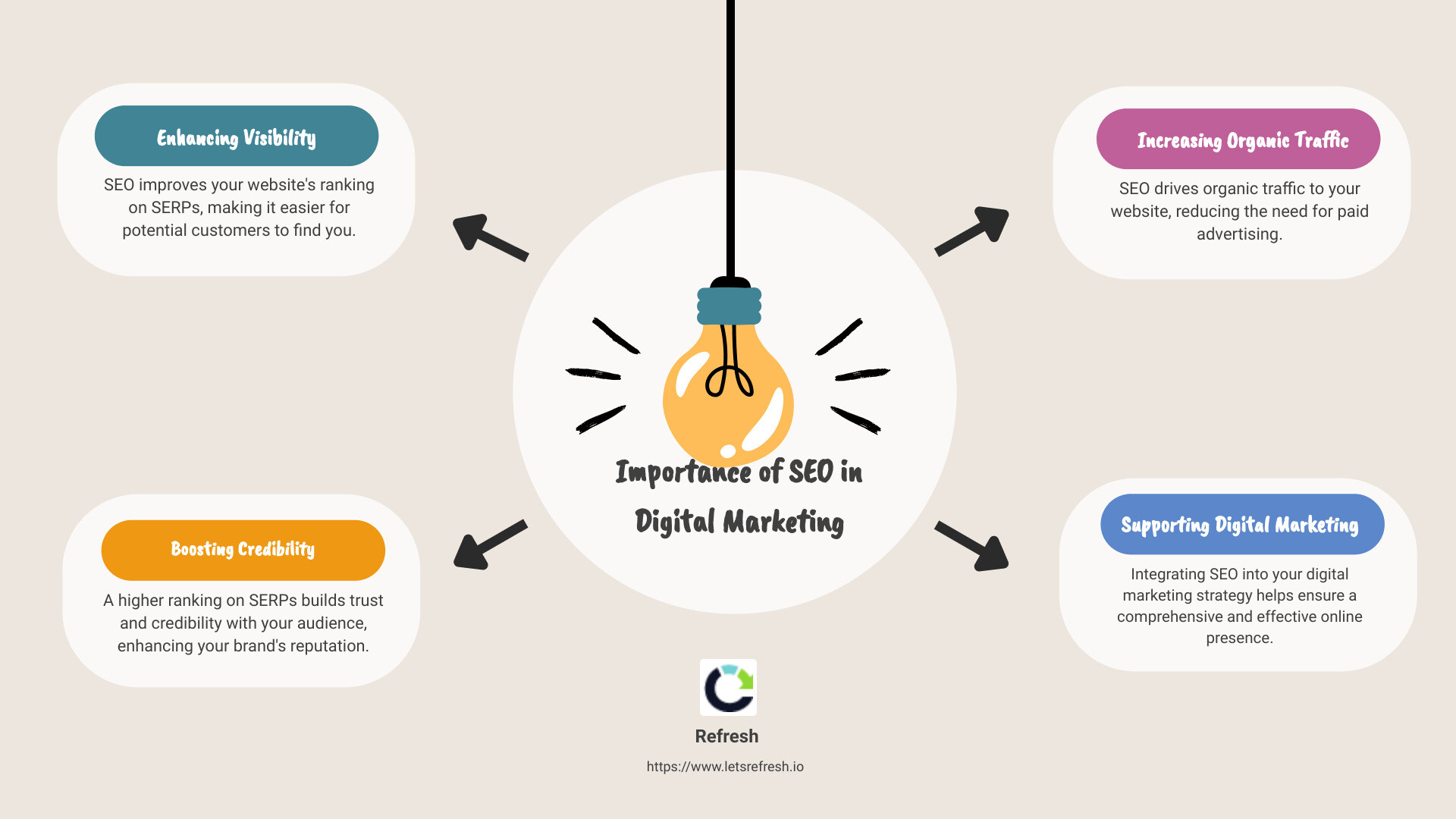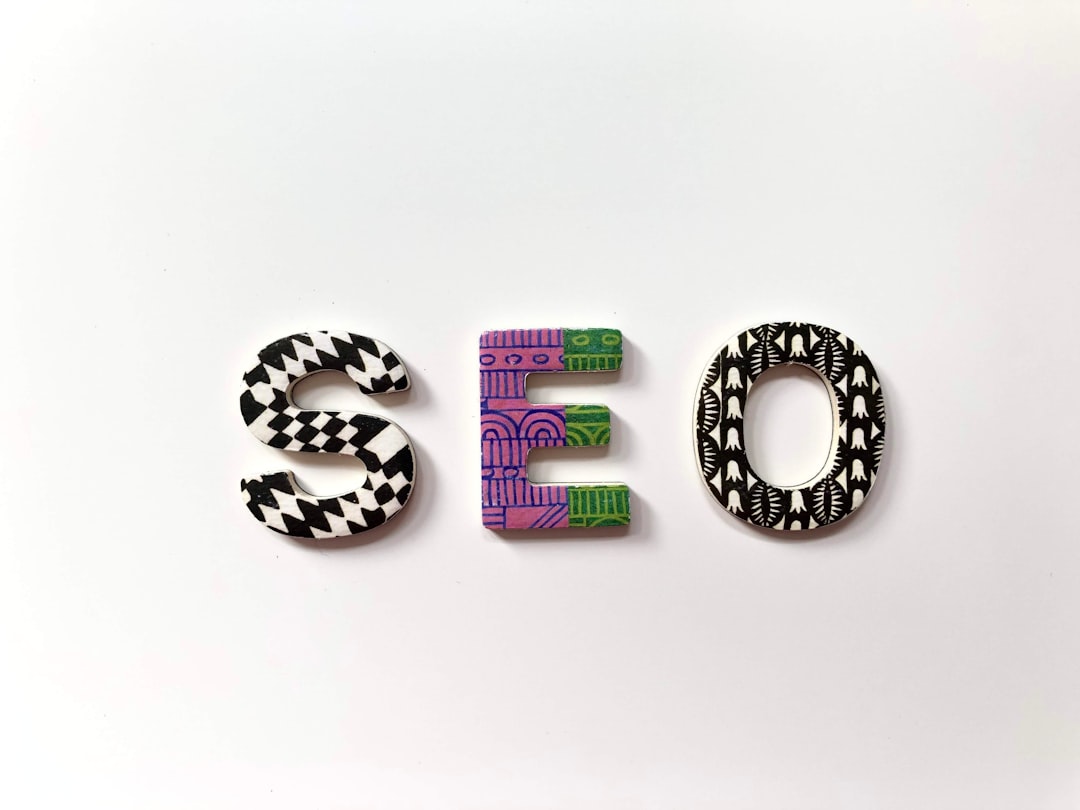July 24, 2025
The Importance of SEO in Digital Marketing
When you search for "seo digital marketing meaning", you're looking for ways to improve your website's visibility online. Here's a quick breakdown:
- SEO (Search Engine Optimization): Improves your website's ranking on search engine results pages (SERPs).
- Digital Marketing: Uses digital channels to promote products, services, or brands.
- Importance of SEO: Helps increase organic traffic, boosts credibility, and supports broader digital marketing efforts.
In simpler terms, SEO is like setting up a big sign on a busy street, ensuring your business gets noticed among the crowd. When integrated into your digital marketing plan, SEO makes sure your business reaches potential customers right when they're searching for what you offer.
I'm Alexander Palmiere, founder of Refresh Digital Strategy. With experience in seo digital marketing meaning and helping numerous businesses boost their online presence, I know how to make SEO work for you.

What is SEO?
The Basics of SEO
Search Engine Optimization (SEO) is the practice of improving your website to increase its visibility when people search for products, services, or information in search engines like Google or Bing. The better your site’s visibility, the more likely you are to attract organic traffic, which can lead to more customers or clients.
SEO involves several key elements:
- Keyword Research: Identifying the terms and phrases people use to search for your products or services.
- Content Creation: Producing high-quality, relevant content that answers the questions your target audience is asking.
- Technical Optimization: Ensuring your website meets the technical requirements of search engines, such as fast loading times and mobile-friendliness.
- Link Building: Acquiring links from other reputable websites to improve your own site’s authority and credibility.
Types of SEO
SEO can be broken down into different types, each focusing on a specific aspect of your website's performance and visibility.
On-Page SEO
On-page SEO refers to the optimization of individual web pages to rank higher and earn more relevant traffic in search engines. Key elements include:
- Title Tags: Shortened versions of your page titles that should include primary keywords.
- Meta Descriptions: Brief summaries of your page content that appear in search results.
- Content: High-quality, keyword-rich content that provides value to users.
- Internal Linking: Linking to other relevant pages on your website to improve navigation and context.
Off-Page SEO
Off-page SEO focuses on activities outside your website that impact your rankings. This includes:
- Backlinks: Links from other websites pointing to your content.
- Social Media Signals: Engagements like shares, likes, and comments on social media platforms.
- Online Reviews: Customer testimonials and reviews on third-party sites.
Technical SEO
Technical SEO involves optimizing your website's backend to help search engines crawl and index your site more effectively. Key areas include:
- Site Speed: Ensuring your pages load quickly.
- Mobile-Friendliness: Making sure your site performs well on mobile devices.
- XML Sitemaps: Creating sitemaps to help search engines understand your site structure.
- Robots.txt: Managing which pages search engines can crawl and index.
Local SEO
Local SEO aims to increase your website's visibility for local searches. This is crucial for businesses that serve a specific geographic area. Key strategies include:
- Google My Business: Creating and optimizing your business listing.
- Local Keywords: Using keywords that include location-specific terms.
- Customer Reviews: Encouraging satisfied customers to leave positive reviews.
By understanding and implementing these types of SEO, you can improve your website's visibility, attract more organic traffic, and ultimately grow your business.

Next, we'll dive deeper into how SEO boosts your online authority and credibility.
The Role of SEO in Digital Marketing
Boosting Online Authority and Credibility
SEO is crucial in digital marketing because it helps build your online authority and credibility. When your website ranks high on search engines, it signals to users and search engines that your site is a trusted source of information. This trust can boost your brand reputation and encourage more visitors to engage with your content.
Off-page SEO, such as link building and social media marketing, plays a significant role in establishing credibility. When reputable websites link to your content, search engines see this as a vote of confidence. This can improve your rankings and make your site appear more authoritative to users.
For example, a local bakery that gets mentioned in local food blogs and receives positive online reviews will likely see a boost in its local search rankings. This increases its visibility and attracts more local customers.
Improving Organic Search Rankings
One of the primary goals of SEO is to improve your website's position in organic search results. Higher rankings lead to greater visibility and more traffic, which can translate into more leads and sales.
Keyword optimization is essential for improving your search rankings. By researching and using relevant keywords, you can create content that answers the questions your target audience is asking. This makes your content more relevant and useful, which search engines reward with higher rankings.
Technical SEO also plays a crucial role. Ensuring your website is fast, mobile-friendly, and easy to steer helps search engines crawl and index your site more effectively. A technically optimized site can significantly improve your search rankings.
Link building is another key factor. Acquiring high-quality backlinks from reputable sites can improve your site’s authority and improve its ranking.
Enhancing User Experience
SEO is not just about search engines; it's also about providing a better experience for users. An optimized website is easier to steer, faster, and more user-friendly, which can lead to higher engagement and lower bounce rates.
Website structure and navigation are critical for user experience. A well-organized site helps users find the information they need quickly and easily. This can keep them on your site longer and reduce your bounce rate.
Mobile-friendliness is another important factor. With more people using mobile devices to browse the internet, ensuring your site performs well on mobile can improve both user experience and search rankings.
Page speed is also crucial. Faster-loading pages provide a better user experience and are favored by search engines. Google, for example, has indicated that page speed is a ranking factor.
By focusing on these aspects, you can improve the user experience, which can lead to higher engagement, more conversions, and better search rankings.
Next, we’ll explore the differences between SEO and PPC (Pay-Per-Click) advertising and how they complement each other in a digital marketing strategy.
SEO vs. PPC: Understanding the Differences
Position and Time
Paid search (PPC) and organic search (SEO) differ significantly in how they appear on search engine results pages (SERPs) and the time it takes to see results.
- Paid results: These appear at the top of SERPs, marked as ads. They provide immediate visibility once your campaign is live. For instance, if you search for "best water bottle," the top results are often paid ads, making them the first thing users see.
- Organic results: These are listed below paid ads. Achieving high rankings in organic search takes time—weeks, months, or even years. It’s a long-term strategy focusing on sustained growth.
Cost and ROI
The costs and return on investment (ROI) for SEO and PPC also vary.
- Pay-per-click (PPC): With PPC, you pay each time someone clicks on your ad. This model can quickly drive traffic to your site but can become expensive over time. For example, Google Ads operates on a cost-per-click (CPC) basis, where you bid for keywords.
- SEO: SEO focuses on generating free traffic. While it requires an upfront investment in resources and time, the traffic you gain is free once you start ranking well. Over time, the ROI from SEO can surpass that of PPC as you continue to receive traffic without ongoing costs.
Traffic and User Intent
Both SEO and PPC aim to drive traffic, but the nature of that traffic and user intent can differ.
- User intent: SEO and PPC both require understanding what users are searching for and why. However, users clicking on organic results might be more inclined to engage deeply with the content, as they perceive it as more trustworthy.
- Keyword research: Both strategies rely on thorough keyword research to target the right audience. With PPC, you bid on keywords to appear in search results. With SEO, you optimize your content to rank for those keywords.
- Landing pages: Effective PPC campaigns usually direct users to specific landing pages designed to convert visitors into customers. In SEO, landing pages are part of your website and aim to provide valuable information that satisfies the user's query.
Conversion
Both SEO and PPC aim to convert visitors into customers, but they do so in different ways.
- PPC: Provides immediate results and is excellent for short-term goals, such as promotions or new product launches. It’s easier to track ROI because you can directly see which ads lead to conversions.
- SEO: Focuses on long-term growth. It may take longer to see results, but the benefits compound over time. Higher organic rankings can lead to ongoing traffic and conversions without additional costs.
In summary, while SEO is a slow-burning strategy that yields long-term benefits, PPC offers immediate visibility and quick results. Understanding their differences helps you use both effectively in your digital marketing strategy.

Next, let’s dive into how search engines work, including the processes of crawling, indexing, and ranking.
How Search Engines Work
Crawling and Indexing
Search engines like Google use web crawlers, often called spiders or robots, to find new web pages. These crawlers follow links from known pages to new ones, continuously exploring the web. When a crawler finds a new page, it stores the page's content in a massive database called an index.
Crawling is the first step. Think of it as search engines sending out tiny robots to browse the internet and find new stuff. These robots, known as Googlebots, steer from link to link, gathering information about each page they visit.
Indexing comes next. Once a page is crawled, the search engine decides if it’s worth storing in its index. If the page is valuable and unique, it gets added to the index. This index is like a giant digital library where search engines store all the web pages they’ve finded.
To see what pages are indexed from your site, you can type site:yourdomain.com into Google’s search bar. This will show you which of your pages are in Google's index.
Ranking Factors
Once a page is in the index, the next step is ranking. When you type a query into a search engine, it looks through its index to find the most relevant pages. But how does it decide which pages are the best? This is where search algorithms come into play.
Search algorithms are complex formulas used by search engines to rank pages. They consider hundreds of factors, but here are some of the most important ones:
- Relevance: The content must match the search query. If someone searches for "best pizza in New York," pages about pizza places in New York will be prioritized.
- Search intent: Google tries to understand what the user really wants. Are they looking to buy, learn, or find a specific site? For example, if the query is "buy pizza in New York," Google will show transactional pages like online ordering sites.
- Content quality: High-quality content is key. This means the content should be well-written, informative, and valuable to the reader.
- User experience: Pages that load quickly, are easy to steer, and work well on mobile devices tend to rank higher. Google prioritizes sites that offer a good user experience.
Understanding these factors can help you optimize your site and improve your rankings. Next, we'll explore some of the specific techniques you can use to boost your SEO.
Frequently Asked Questions about SEO in Digital Marketing
What is SEO in digital marketing salary?
The salary of an SEO expert can vary widely based on experience, location, and the type of employer. Here’s a quick breakdown:
- Entry-level salary: For those just starting out, salaries typically range from $40,000 to $53,000 per year. Entry-level roles often involve tasks like keyword research and on-page optimization.
- Mid-career salary: With a few years of experience, SEO specialists can expect to earn between $53,000 and $75,000 annually. Responsibilities at this level might include managing SEO campaigns and conducting technical audits.
- Experienced salary: Highly experienced SEO professionals, especially those in managerial roles, can make $75,000 to $91,000 or more per year. They often oversee entire SEO strategies and coordinate with other digital marketing efforts.
What is an example of SEO in digital marketing?
One common example of SEO in digital marketing is on-page SEO. This involves optimizing individual web pages to rank higher and earn more relevant traffic in search engines. Here’s how it works:
- Keyword optimization: Identify and use keywords that your target audience is searching for. For instance, if you run a bakery, you might optimize for keywords like "best cupcakes near me" or "gluten-free bread."
- Content creation: Develop high-quality content around those keywords. This could be blog posts, product descriptions, or landing pages. The content should be engaging, informative, and valuable to your audience.
For example, a blog post titled "10 Tips for Baking the Perfect Cupcake" targeting the keyword "baking the perfect cupcake" can help attract users who are interested in baking.
What is the difference between SEO and SEM?
SEO and SEM are both crucial parts of digital marketing, but they have distinct roles:
- SEO (Search Engine Optimization): Focuses on improving organic search rankings. It involves optimizing your website to make it more attractive to search engines. This means using techniques like keyword optimization, content creation, and link building to appear in unpaid search results.
- SEM (Search Engine Marketing): Includes both SEO and paid advertising. It involves using paid ads to increase visibility in search engines. These ads appear at the top or bottom of search engine results pages and are marked as "sponsored" or "ad."
Here’s a quick comparison:
AspectSEOSEMCostGenerally free, but time-intensivePaid (cost-per-click or cost-per-impression)Time to ResultsLong-term (months)Short-term (immediate)Traffic TypeOrganicPaidUser IntentInformational, navigational, transactionalMostly transactional
Understanding the difference helps in crafting a balanced digital marketing strategy that leverages both organic and paid search to maximize visibility and conversions.
Next, we’ll dive into specific techniques to boost your SEO and improve your rankings.
Conclusion
At Refresh, we understand that SEO is not just a tactic; it’s a long-term strategy. This means we focus on continuous improvement and adapting to changes in search engine algorithms, user behavior, and industry trends.
Long-Term Strategy
SEO is a marathon, not a sprint. Results take time, but they are worth the wait. By consistently optimizing your website, creating valuable content, and building quality backlinks, you can achieve sustainable growth. This long-term approach helps your business stay relevant and competitive.
Digital Marketing Integration
SEO is just one piece of the digital marketing puzzle. It works best when integrated with other strategies like social media marketing, content marketing, and email marketing. By combining these efforts, you create a cohesive strategy that amplifies your reach and engagement.
For example, sharing your SEO-optimized blog posts on social media can drive traffic to your website, which in turn can improve your search rankings. Similarly, using email marketing to promote new content can increase user engagement and time spent on your site.
Continuous Improvement
The digital landscape is always changing. Search engines update their algorithms, competitors adapt their strategies, and new technologies emerge. That’s why continuous improvement is crucial. Regularly auditing your website, updating content, and staying informed about industry changes can help you maintain and improve your rankings.
At Refresh, we are committed to helping you thrive online. Our team of experts ensures that your website is optimized for search engines and engaging for users. We focus on both technical SEO and high-quality content to drive organic traffic and improve user experience.
Ready to lift your digital presence? Contact us today to learn how Refresh can drive results for your business.
By embracing the power of SEO and digital marketing, you can open up unparalleled growth and success. Let’s make your success story unfold together.
Still have questions? Let’s talk about it.
.avif)





